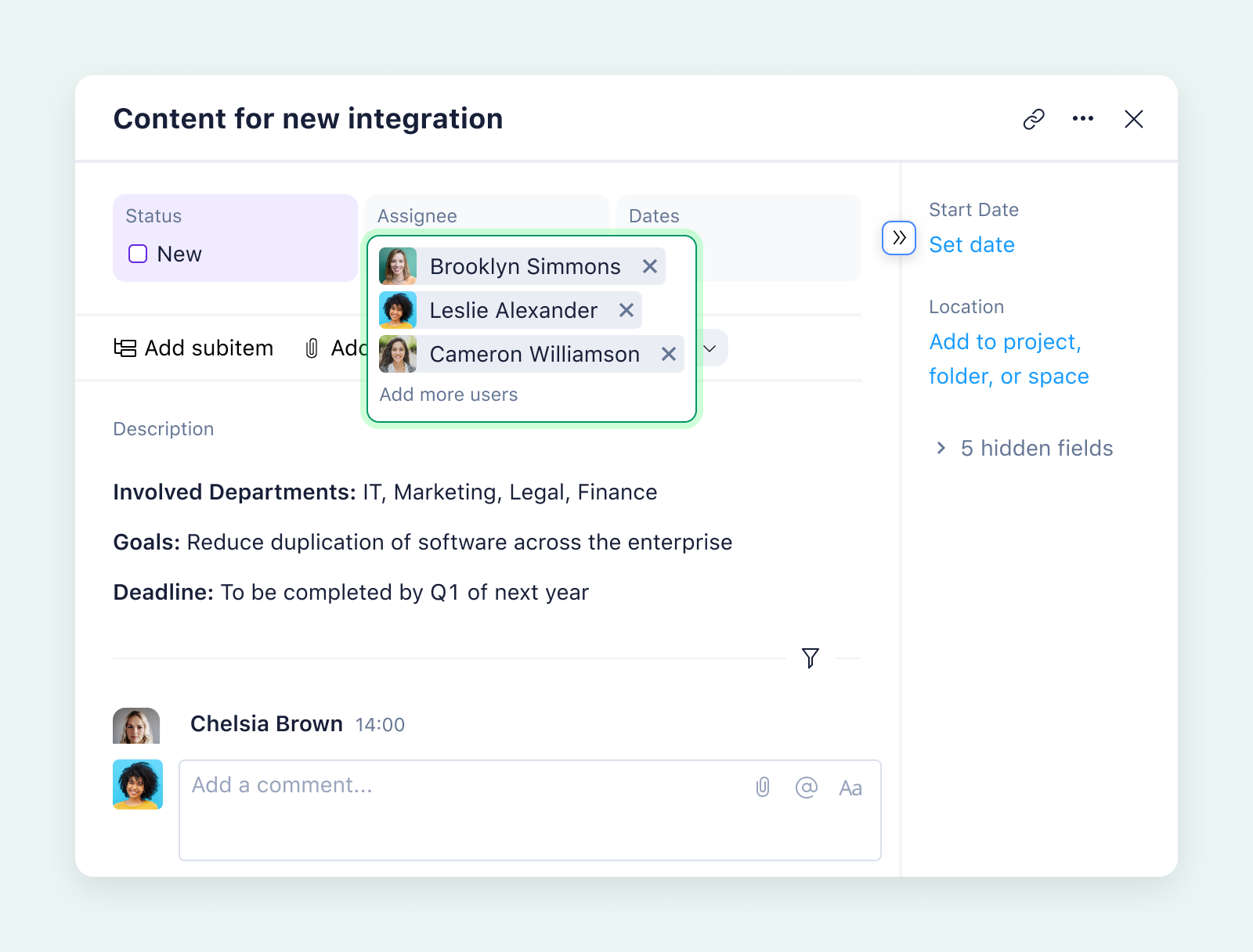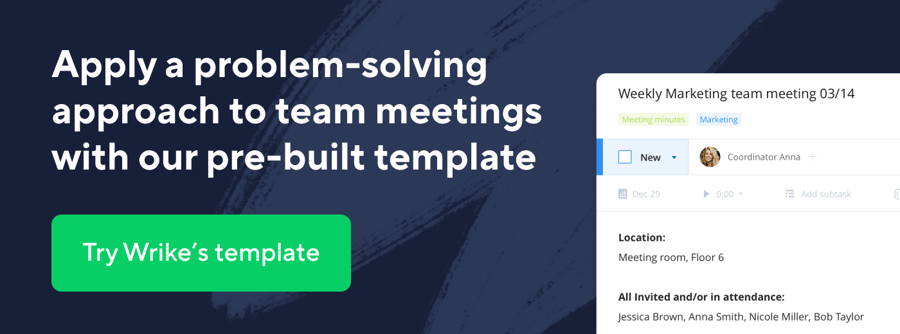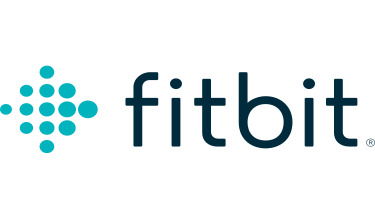Key takeaways:
- What are essential problem-solving skills? Adaptability, collaboration, and effective decision-making are critical for overcoming workplace challenges.
- How does collaboration enhance problem solving? Teams provide diverse perspectives, leading to more insightful solutions than individuals working alone.
- Why is communication vital in problem solving? Clear communication ensures understanding of problems and solutions, especially in remote teams.
- What role do problem-solving activities play? Engaging activities foster teamwork, critical thinking, and creativity in finding solutions.
- How can Wrike support problem solving? Wrike’s tools streamline workflows and enhance collaboration, turning insights from activities into actionable projects.
Some people see problems as roadblocks, others see them as opportunities! Problem-solving activities are a great way to get to know how members of your team work, both individually and together. It’s important to teach your team strategies to help them quickly overcome obstacles in the way of achieving project goals.
Challenges don’t have to mean chaos. With the right tools and mindset, your team can turn even the toughest roadblocks into stepping stones. (Tip: Wrike helps you do that by connecting your workflows, keeping everyone in sync, and making tasks easier to handle.)
In this article, you’ll explore 15 problem-solving activities designed to enhance collaboration and creativity. Additionally, if you want to discuss the insights and outcomes with your team after the activities, you can use Wrike’s actionable meeting notes template. This template allows you to record meeting discussions, assign action items, and ensure that everyone is on the same page.
The importance of problem-solving skills in today’s workplace
According to a 2019 report by McKinsey, soft skills are increasingly important in today’s world — and problem solving is the top area in which skills are lacking. A company or team’s success weighs heavily on the willingness of managers to help employees improve their problem-solving abilities. Team-building activities targeting focus areas like communication and collaboration, adaptability, or strengthening decision-making techniques help.
All problem-solving processes start with identifying the problem. Next, the team must assess potential courses of action and choose the best way to tackle the problem. This requires a deep understanding of your team and its core strengths. A problem-solving exercise or game helps identify those strengths and builds problem-solving skills and strategies while having fun with your team.
Once your team knows exactly who’s good at what, it’s easier to assign tasks where each person can make an impact. That synergy is what keeps projects on track when unforeseen challenges arise.

Problem-solving games aren’t for just any team. Participants must have an open mind and accept all ideas and solutions. They must also have an Agile mindset and embrace different structures, planning, and processes. Problems usually arise when we least expect them, so there’s no better way to prepare than to encourage agility and flexibility.
Another aspect to keep in mind when engaging in problem-solving games and activities: There are no winners or losers. Sure, some games might end with a single winner, but the true goal of these exercises is to learn how to work together as a team to develop an Agile mindset. The winning team of each game should share their strategies and thought processes at the end of the exercise to help everyone learn.
Here’s a list of fun problem-solving activity examples to try with your team. From blindfolds to raw eggs, these problem-solving, team-building activities will have your team solving problems faster than Scooby and the gang.

Classic team-building, problem-solving activities
1. A Shrinking Vessel
Helps with: Adaptability
Why adaptability is important for problem solving: Adaptability is highly associated with cognitive diversity, which helps teams solve problems faster, according to the Harvard Business Review. Innovation and disruption are happening faster than ever before. People, teams, and organizations that can adapt will come out on top.
What you’ll need:
- A rope or string
Instructions:
1. Using the rope, make a shape on the floor everyone can fit into.
2. Slowly shrink the space over 10-15 minutes.
3. Work together to figure out how to keep everyone within the shrinking boundaries.
2. Marshmallow Spaghetti Tower
Helps with: Collaboration
Why collaboration is important for problem solving: “Collectively, we can be more insightful, more intelligent than we can possibly be individually,” writes Peter Senge in The Fifth Discipline. We can solve problems better as a team than we can alone, which means developing your team’s collaboration skills will lead to better problem-solving outcomes.
As your team scrambles to build the highest tower, they’ll see how tasks in a single workflow depend on each other. Every piece, each strand of spaghetti, must support the rest. The same principle applies to complex work projects, where collaboration is the key to staying upright.
What you’ll need (per team):
- 20 sticks of uncooked spaghetti
- 1 roll of masking tape
- 1 yard of string
- 1 marshmallow
Instructions:
1. The goal of this exercise is to see which team can use the materials provided to build the tallest tower within an allotted time period. The tower must be able to stand on its own.
2. To make this exercise more challenging, try adding a marshmallow to the top of the tower. This team problem-solving exercise helps people think on their toes while building camaraderie and leadership.
3. Egg Drop
Helps with: Collaboration, decision making
Why decision making is important for problem solving: Making decisions isn’t easy, but indecision leads to team paralysis, stagnant thinking, and unsolved problems. Decision-making activities help your team practice making quick, effective choices. Train your team’s decision-making muscles and they will become more adept at problem solving.
When your teammates debate the best egg carrier design, it mirrors real-world project moments: “Which approach do we choose?” The faster they test solutions, the more smoothly work can move from one stage to the next in your shared workflow.
What you’ll need:
- A carton of eggs
- Basic construction materials such as newspapers, straws, tape, plastic wrap, balloons, rubber bands, popsicle sticks, etc., tarp, or drop cloth
- A parking lot, or some other place you don’t mind getting messy!
Instructions:
1. Each team gets an egg and must select from the construction materials.
2. Give everyone 20-30 minutes to construct a carrier for the egg and protect it from breaking.
3. Drop each egg carrier off a ledge (i.e. over a balcony) and see whose carrier protects the egg from breaking.
4. If multiple eggs survive, keep increasing the height until only one egg is left.
4. Stranded
Helps with: Communication, decision making
Why communication is important for problem solving: More employees work remotely than ever before. Good communication skills are vital to solving problems across virtual teams. Working on communication skills while your team is together will help them solve problems more effectively when they’re apart.
What you’ll need:
- An office
Here’s the setting: Your team has been stranded in the office. The doors are locked, and knocking down the doors or breaking the windows is not an option. Give your team 30 minutes to decide on 10 items in the office they need for survival and rank them in order of importance. The goal of the game is to have everyone agree on the 10 items and their rankings in 30 minutes.
5. Legoman
Helps with: Communication
What you’ll need:
- Lego
Instructions:
1. Divide everyone into small teams of two or more.
2. Select an overseer who isn’t on a team to build a random structure using Lego building blocks within 10 minutes.
3. The other teams must replicate the structure exactly (including size and color) within 15 minutes. However, only one member from each group may look at the original structure. They must figure out how to communicate the size, color, and shape of the original structure to their team.
4. If this is too easy, add a rule that the member who can see the original structure can’t touch the new structure.
6. Escape
Helps with: Collaboration
What you’ll need:
- 1 rope
- 1 key
- A lockable room
- 5-10 puzzles or clues (depending on how much time you want to spend on the game)
Instructions:
1. The goal of this exercise is to solve the clues, find the key, and escape a locked room within the time allotted.
2. Hide the key and a list of clues around the room.
3. Gather the team into the empty room and “lock” the door.
4. Give them 30 minutes to an hour to find the key using the clues hidden around the room.
7. Frostbite
Helps with: Decision making, adaptability
What you’ll need:
- A blindfold
- 1 packet of construction materials (such as card stock, toothpicks, rubber bands, and sticky notes) for each team
- An electric fan
Instructions: Your employees are Arctic explorers adventuring across an icy tundra! Separate them into teams of four or five and have them select a leader to guide their exploration. Each team must build a shelter from the materials provided before the storm hits in 30 minutes. However, both the team leader’s hands have frostbite, so they can’t physically help construct the shelter, and the rest of the team has snow blindness and is unable to see. When the 30 minutes are up, turn on the fan and see which shelter can withstand the high winds of the storm.
8. Minefield
Helps with: Communication
What you’ll need:
- An empty room or hallway
- Blindfolds
- A collection of common office items
Instructions:
1. Place the items (boxes, chairs, water bottles, bags, etc.) around the room so there’s no clear path from one end of the room to the other.
2. Divide your team into pairs and blindfold one person on the team.
3. The other must verbally guide that person from one end of the room to the other, avoiding the “mines.”
4. The partner who is not blindfolded can’t touch the other.
5. If you want to make the activity more challenging, have all the pairs go simultaneously so teams must find ways to strategically communicate with each other.
9. Blind Formations
Helps with: Communication
What you’ll need:
- Blindfolds
- Rope
Instructions:
1. Have the group put on blindfolds and form a large circle.
2. Tie two ends of a rope together and lay it in a circle in the middle of the group, close enough so each person can reach down and touch it.
3. Instruct the group to communicate to create a shape with the rope — a square, triangle, rectangle, etc.
4. If you have a very large group, divide them into teams and provide a rope for each team. Let them compete to see who forms a particular shape quickest.
10. Line Up Blind
Helps with: Communication
What you’ll need:
- Blindfolds
Instructions:
1. Blindfold everyone and whisper a number to each person, beginning with one.
2. Tell them to line up in numerical order without talking.
3. Instead of giving them a number, you could also have them line up numerically by height, age, birthday, etc.
11. Reverse Pyramid
Helps with: Adaptability, collaboration
What you’ll need:
- Nothing
Instructions:
1. Have everyone stand in a pyramid shape, horizontally.
2. Ask them to flip the base and the apex of the pyramid moving only three people.
3. This quick exercise works best when smaller groups compete to see who can reverse the pyramid the fastest.
12. Move It!
Helps with: Adaptability, collaboration
What you’ll need:
- Chalk, rope, tape, or paper (something to mark a space)
Instructions:
1. Divide your group into two teams and line them up front to back, facing each other.
2. Using the chalk, tape, rope, or paper (depending on the playing surface), mark a square space for each person to stand on. Leave one extra empty space between the two facing rows.
3. The goal is for the two facing lines of players to switch places.
4. Place these restrictions on movement:
- Only one person may move at a time.
- A person may not move around anyone facing the same direction.
- No one may not move backward.
- A person may not move around more than one person on the other team at a time.
13. Human Knot
Helps with: Adaptability, collaboration
What you’ll need:
- Nothing
Instructions:
1. Have everyone stand in a circle, and ask each person to hold hands with two people who aren’t directly next to them.
2. When everyone is tangled together, ask them to untangle the knot and form a perfect circle — without letting go of anyone’s hand.
Our last two problem-solving activities work best when dealing with an actual problem:
14. Dumbest Idea First
Helps with: Instant problem solving
What you’ll need:
- Nothing
Instructions:
1. “Dumb” ideas are sometimes the best ideas. Ask everyone to think of the absolute dumbest possible solution to the problem at hand.
2. After you have a long list, look through it and see which ones might not be as dumb as you think.
3. Brainstorm your solutions in Wrike. It’s free and everyone can start collaborating instantly!
15. What Would X Do
Helps with: Instant problem solving
What you’ll need:
- Nothing
Instructions:
1. Have everyone pretend they’re someone famous.
2. Each person must approach the problem as if they were their chosen famous person. What options would they consider? How would they handle it?
3. This allows everyone to consider solutions they might not have thought of originally.
Looking for more team-building and virtual meeting games? Check out these virtual icebreaker games or our ultimate guide to team-building activities.
- Problem-Solving Model: Looking for a model to provide a problem-solving structure? This detailed guide gives you the tools to quickly solve any problem.
- The Simplex Process: Popularized by Min Basadur’s book, The Power of Innovation, the Simplex Process provides training and techniques for each problem-solving stage. It helps frame problem solving as a continuous cycle, rather than a “one and done” process.
- Fun Problem-Solving Activities and Games: Looking for more ideas? Check out this list of interesting and creative problem-solving activities for adults and kids!
- The Secret to Better Problem Solving: This article provides tips, use cases, and fresh examples to help you become a whiz at solving the toughest problems.
Problem solving is more than just finding quick fixes. It creates an environment where teams can work together, adapt, and thrive. These activities are the perfect starting point to strengthen collaboration and decision making. But how do you make the results stick?
The answer is Wrike. With our collaborative work management software, you can use what you’ve learned from these problem-solving games to create better workflows, assign tasks clearly, and keep everyone aligned.
In particular, Wrike’s prebuilt actionable meeting notes template helps you keep track of meeting discussions, assign action items, and keep everyone in the loop. It’s an effective tool to streamline your problem-solving sessions and turn insights into real projects.
One of Wrike’s customers is Fitbit, a wearable technology brand known for monitoring physical activity and sleep. According to Brynne Roberts, Director of Creative Operations, Fitbit switched to Wrike for a more sustainable workflow that could withstand turbulent market conditions and keep team members accountable during essential projects.

We leave meetings ready to work. We walk out feeling confident that we can share that timeline with the stakeholder and say, ’As long as you stick to your deadlines, we will stick to ours.’ ... I could confidently say that having timeline templates and dynamic timelines has cut down on PM time by at least 50%, specific to time building and management.
Brynne Roberts, Director of Creative Operations





